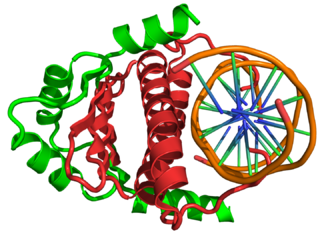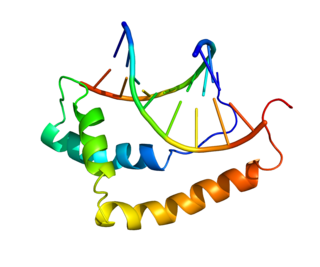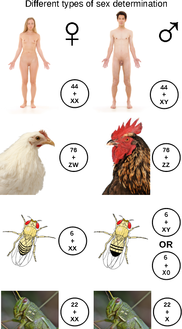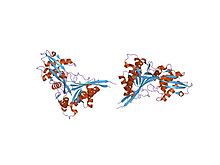
Testis-determining factor (TDF), also known as sex-determining region Y (SRY) protein, is a DNA-binding protein encoded by the SRY gene that is responsible for the initiation of male sex determination in humans. SRY is an intronless sex-determining gene on the Y chromosome in therians ; mutations in this gene lead to a range of disorders of sex development (DSD) with varying effects on an individual's phenotype and genotype.

Dosage compensation is the process by which organisms equalize the expression of genes between members of different biological sexes. Across species, different sexes are often characterized by different types and numbers of sex chromosomes. In order to neutralize the large difference in gene dosage produced by differing numbers of sex chromosomes among the sexes, various evolutionary branches have acquired various methods to equalize gene expression among the sexes. Because sex chromosomes contain different numbers of genes, different species of organisms have developed different mechanisms to cope with this inequality. Replicating the actual gene is impossible; thus organisms instead equalize the expression from each gene. For example, in humans, females (XX) silence the transcription of one X chromosome of each pair, and transcribe all information from the other, expressed X chromosome. Thus, human females have the same number of expressed X-linked genes as do human males (XY), both sexes having essentially one X chromosome per cell, from which to transcribe and express genes.

The ZW sex-determination system is a chromosomal system that determines the sex of offspring in birds, some fish and crustaceans such as the giant river prawn, some insects, and some reptiles, including Komodo dragons. The letters Z and W are used to distinguish this system from the XY sex-determination system.

CCAAT-enhancer-binding proteins is a family of transcription factors composed of six members, named from C/EBPα to C/EBPζ. They promote the expression of certain genes through interaction with their promoters. Once bound to DNA, C/EBPs can recruit so-called co-activators that in turn can open up chromatin structure or recruit basal transcription factors.

c-Jun N-terminal kinases (JNKs), were originally identified as kinases that bind and phosphorylate c-Jun on Ser-63 and Ser-73 within its transcriptional activation domain. They belong to the mitogen-activated protein kinase family, and are responsive to stress stimuli, such as cytokines, ultraviolet irradiation, heat shock, and osmotic shock. They also play a role in T cell differentiation and the cellular apoptosis pathway. Activation occurs through a dual phosphorylation of threonine (Thr) and tyrosine (Tyr) residues within a Thr-Pro-Tyr motif located in kinase subdomain VIII. Activation is carried out by two MAP kinase kinases, MKK4 and MKK7, and JNK can be inactivated by Ser/Thr and Tyr protein phosphatases. It has been suggested that this signaling pathway contributes to inflammatory responses in mammals and insects.

Mitogen-activated protein kinase 9 is an enzyme that in humans is encoded by the MAPK9 gene.

In the field of molecular biology, myocyte enhancer factor-2 (Mef2) proteins are a family of transcription factors which through control of gene expression are important regulators of cellular differentiation and consequently play a critical role in embryonic development. In adult organisms, Mef2 proteins mediate the stress response in some tissues. Mef2 proteins contain both MADS-box and Mef2 DNA-binding domains.

The steroidogenic factor 1 (SF-1) protein is a transcription factor involved in sex determination by controlling activity of genes related to the reproductive glands or gonads and adrenal glands. This protein is encoded by the NR5A1 gene, a member of the nuclear receptor subfamily, located on the long arm of chromosome 9 at position 33.3. It was originally identified as a regulator of genes encoding cytochrome P450 steroid hydroxylases, however, further roles in endocrine function have since been discovered.

Activating transcription factor 4 , also known as ATF4, is a protein that in humans is encoded by the ATF4 gene.

Transcription factor SOX-9 is a protein that in humans is encoded by the SOX9 gene.

Transcription factor HES1 is a protein that is encoded by the Hes1 gene, and is the mammalian homolog of the hairy gene in Drosophila. HES1 is one of the seven members of the Hes gene family (HES1-7). Hes genes code nuclear proteins that suppress transcription.

MHC class II regulatory factor RFX1 is a protein that, in humans, is encoded by the RFX1 gene located on the short arm of chromosome 19.

Glia-activating factor is a protein that in humans is encoded by the FGF9 gene.

POU domain, class 4, transcription factor 1 (POU4F1) also known as brain-specific homeobox/POU domain protein 3A (BRN3A), homeobox/POU domain protein RDC-1 or Oct-T1 is a protein that in humans is encoded by the POU4F1 gene.

Heart- and neural crest derivatives-expressed protein 1 is a protein that in humans is encoded by the HAND1 gene.

Doublesex and mab-3 related transcription factor 1, also known as DMRT1, is a protein which in humans is encoded by the DMRT1 gene.

SOX12 is a protein that in humans is encoded by the SOX12 gene. Sox12 belongs to the SoxC group of Sox family of transcription factors, together with Sox4 and Sox11. Sox12-null knockout mice appear normal, unlike Sox4 or Sox11 knockout mice. This probably comes from functional redundancy with Sox4 and Sox11. Sox12 is a weaker activator than both Sox4 and Sox11 in mouse.

In molecular biology the DM domain is a protein domain first discovered in the doublesex proteins of Drosophila melanogaster and is also seen in proteins from Caenorhabditis elegans. In D. melanogaster the doublesex gene controls somatic sexual differentiation by producing alternatively spliced mRNAs encoding related sex-specific polypeptides. These proteins are believed to function as transcription factors on downstream sex-determination genes, especially on neuroblast differentiation and yolk protein genes transcription. The DM domain binds DNA as a dimer, allowing the recognition of pseudopalindromic sequences. The NMR analysis of the DSX DM domain revealed a novel zinc module containing 'intertwined' CCHC and HCCC zinc-binding sites. The recognition of the DNA requires the carboxy-terminal basic tail which contacts the minor groove of the target sequence.
SoxC group is group C of Sry-related HMG box proteins transcription factors. SoxC genes play an important role in determining the cell fate of neuronal mesenchymal progenitor cells in many developmental processes.
The public domain consists of all the creative works to which no exclusive intellectual property rights apply. Those rights may have expired, been forfeited, expressly waived, or may be inapplicable.

Pfam is a database of protein families that includes their annotations and multiple sequence alignments generated using hidden Markov models. The most recent version, Pfam 31.0, was released in March 2017 and contains 16,712 families.
InterPro is a database of protein families, domains and functional sites in which identifiable features found in known proteins can be applied to new protein sequences in order to functionally characterise them.

























